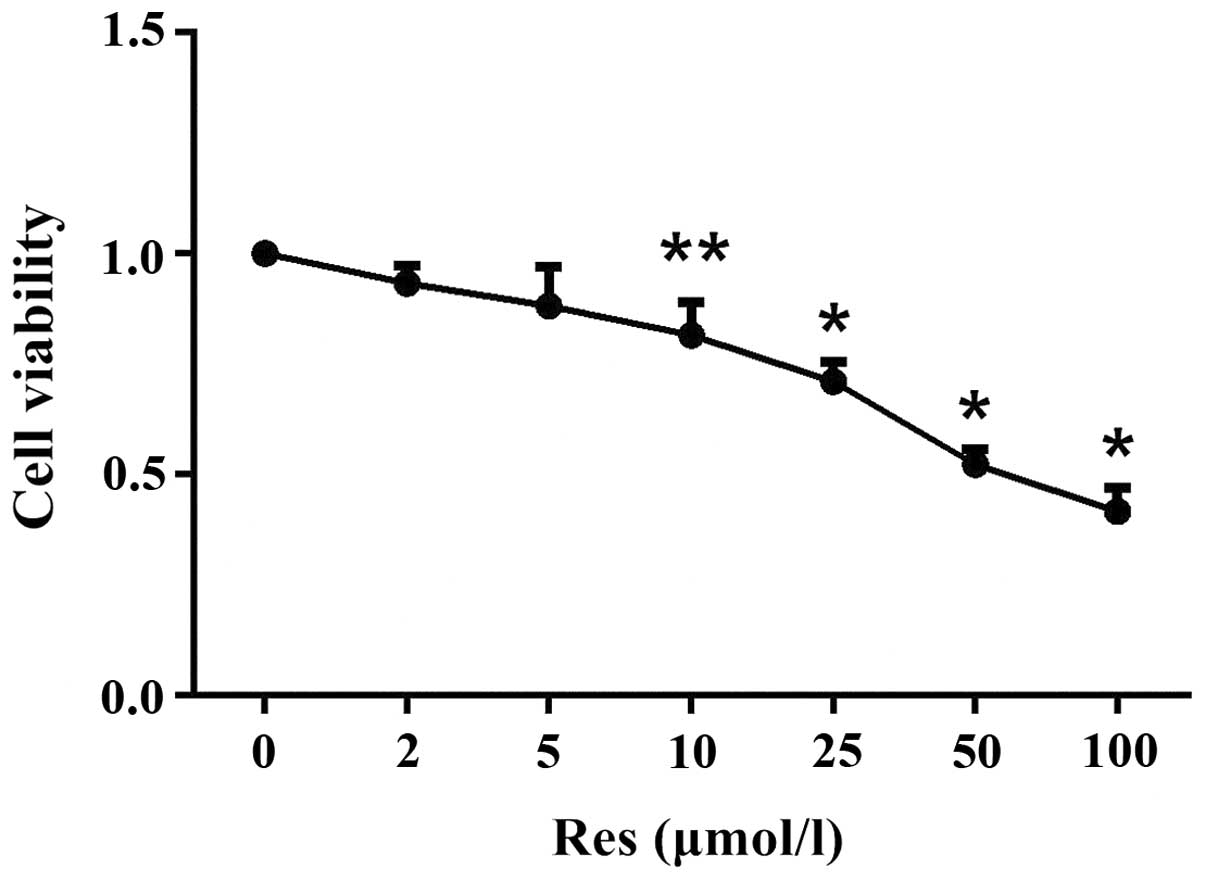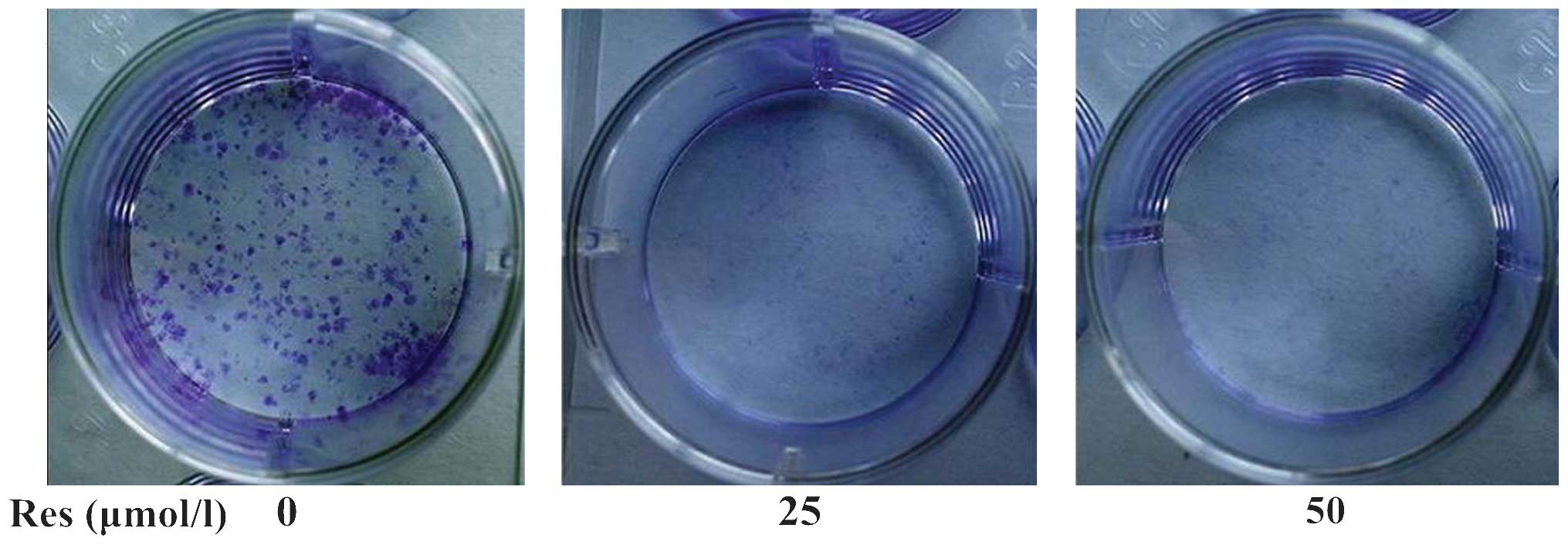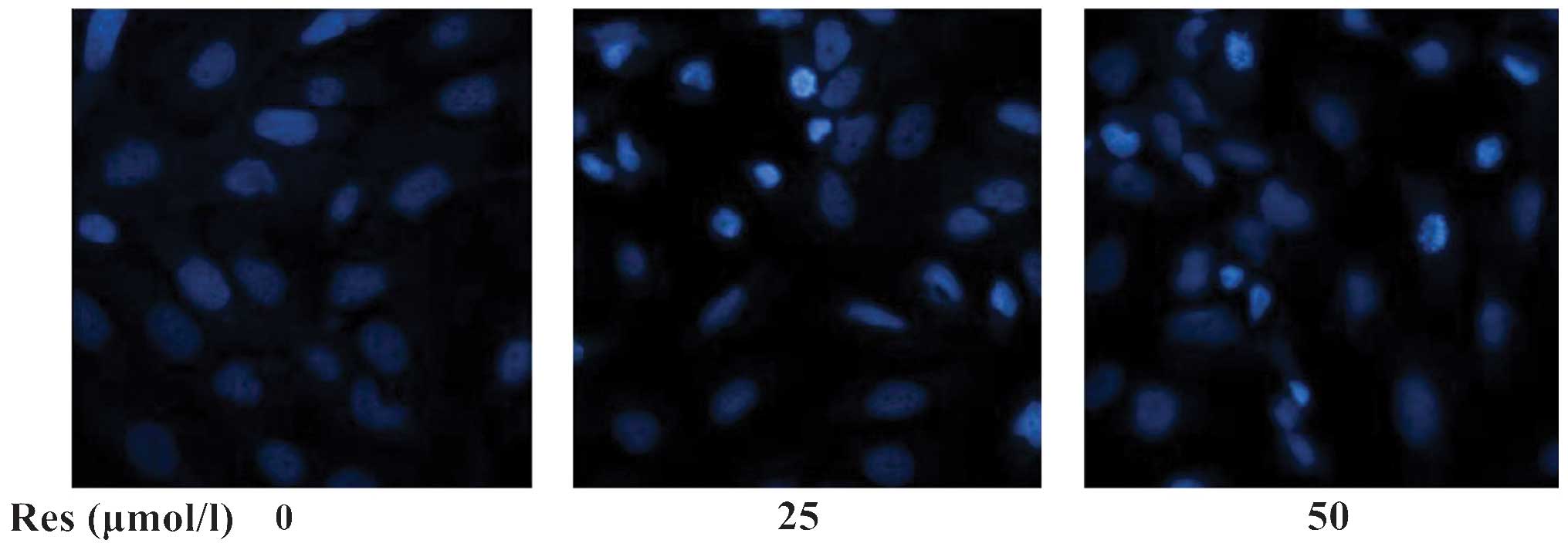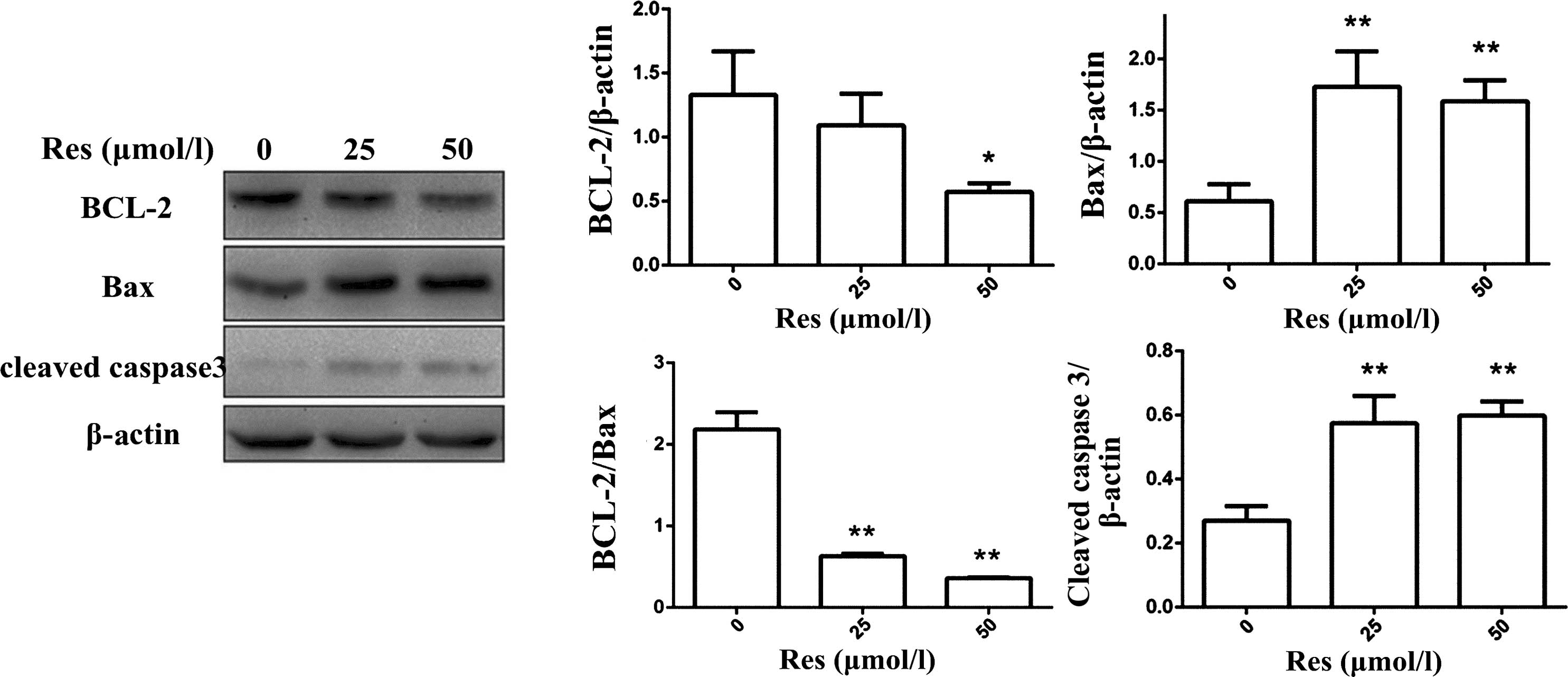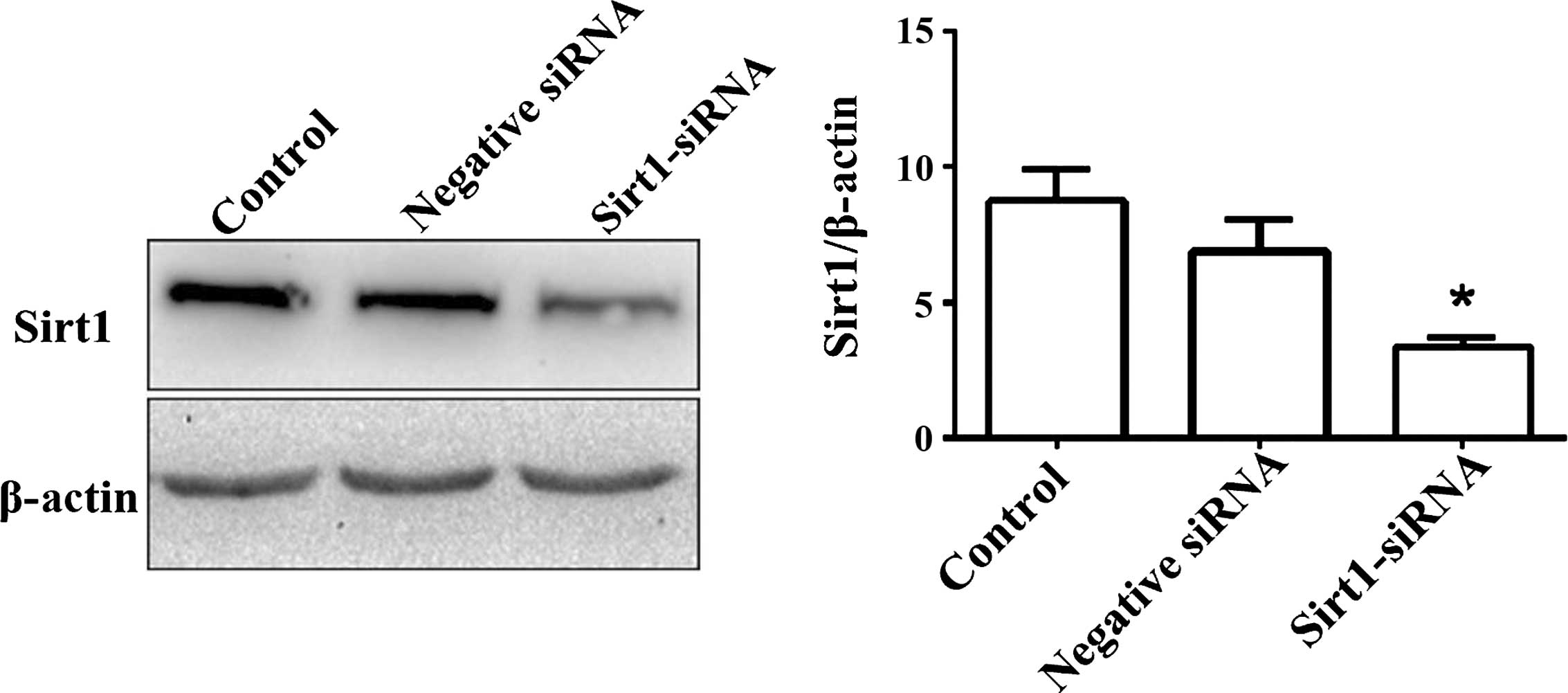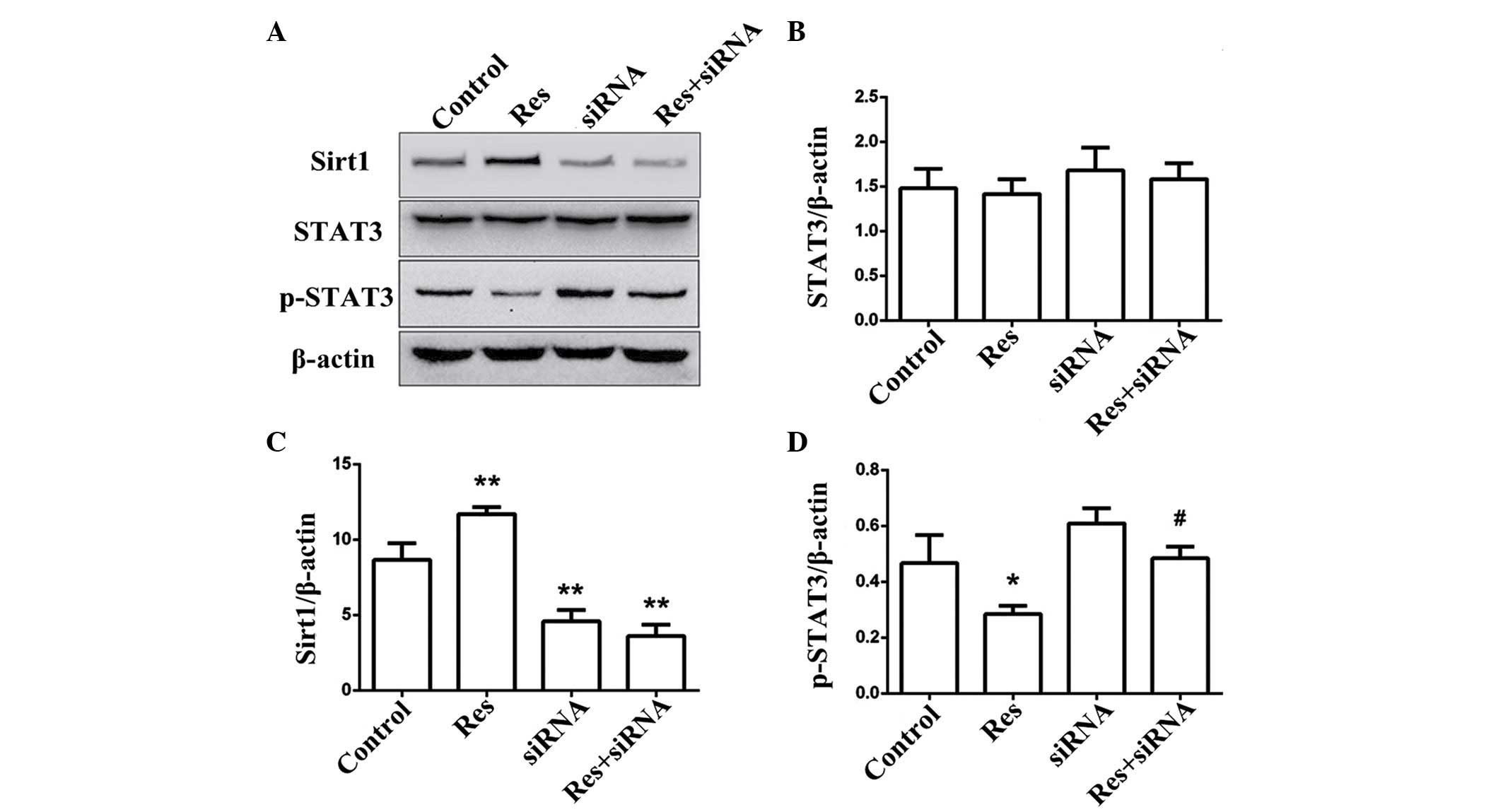Resveratrol inhibits phosphorylation within the signal transduction and activator of transcription 3 signaling pathway by activating sirtuin 1 in SW1353 chondrosarcoma cells
- Authors:
- Published online on: July 27, 2016 https://doi.org/10.3892/mmr.2016.5554
- Pages: 2685-2690
Abstract
Introduction
Chondrosarcoma is the second most common bone cancer, after osteosarcoma (1). Characteristically, chondrosarcomas contain chondroid cells and a matrix. Surgical excision is the mainstay of treatment, with radiotherapy as an alternative if surgery is contraindicated or if a metastasis requires treatment. Although radiotherapy eliminates tumor cells, normal cells are also harmed. As the side-effects of radiotherapy are therefore serious, more effective anti-chondrosarcoma drugs with minimal toxicity are urgently required. Resveratrol (Res), a dietary phytochemical found in almost 70 plant species, has attracted widespread attention due to the anti-tumor activities it exerts on several types of cancer cell, including hepatocellular carcinoma and gastric cancer cells. However, its effect on chondrosarcoma cells remains unknown. Sirtuin 1 (Sirt1), a histone deacetylase, is widely expressed in various tumor types, including gastric cancer, osteosarcoma and colon cancer. It is well known that Res is an effective agonist of Sirt1 (2).
Signal transduction and activator of transcription 3 (STAT3), a protein constitutively expressed in numerous tissues and cell types, regulates the proliferation, differentiation and apoptosis of normal cells, and maintains normal physiological processes. STAT3 is upregulated in several tumor cells, and it has become increasingly accepted that such upregulation is closely associated with tumorigenesis. Furthermore, previous studies have shown that Res inhibits phosphorylation within the STAT3 signaling pathway in numerous types of tumor cells. However, it remains unknown whether Res exerts similar actions in chondrosarcoma cells and, if so, whether Res activates Sirt1 in such cells. The present study assessed the inhibitory effects of Res on chondrosarcoma cells and the underlying mechanisms. In the present study, it was shown that Res induced apoptosis, inhibited cell proliferation and suppressed phosphorylation within the STAT3 signaling pathway by activating Sirt1 in chondrosarcoma cells.
Materials and methods
Cell culture and reagents
Chondrosarcoma SW1353 cells (Chinese Academy of Life Sciences; Shanghai, China) were cultured in Dulbecco's modified Eagle's medium (DMEM)/F12 medium, supplemented with 10% (v/v) fetal bovine serum (FBS), penicillin and streptomycin, at 37°C in a humidified atmosphere containing 5% (v/v) CO2. Res and the Hoechst 33258 reagent were purchased from Sigma-Aldrich (St. Louis, MO, USA). Rabbit antibodies against B-cell lymphoma (BCL)-2 (cat. no. 4223), BCL-2 associated X protein (Bax; cat. no. 5023), caspase 3 (cat. no. 9662), STAT3 (cat. no. 4904), and phosphorylated (p-)STAT3 (cat. no. 9145) were purchased from Cell Signaling Technology, Inc., (Danvers, MA, USA). The cell counting kit (CCK)-8 reagent and Crystal Violet staining solution were purchased from the Beyotime Institute of Biotechnology (Shanghai, China). The Endofectin™-Plus transfection reagent was purchased from Genecopoeia (Guangzhou, China). A specific Sirt1-small interfering (si) RNA was purchased from GenePharma (Shanghai, China).
CCK-8 assay
SW1353 cells were seeded into 96-well plates at a density of 1×104 cells/well and divided into three groups: Blank, Control and Res-treated (2, 5, 10, 25, 50 or 100 µmol/l) groups. After 24 h treatment, 10 µl CCK-8 solution was added to each well and the plate was incubated at 37°C for 1 h. Cell viability was determined by measuring the absorbance (A) at 450 nm using a microplate reader (Thermo Fisher Scientific, Inc.). The percentage of proliferative cells were calculated as follows: Relative viability (%) = (A450treated − A450blank) / (A450control − A450blank) × 100.
Colony formation assay
The cells were seeded into 12-well plates at a density of 1,000 cells/well (1 ml/well) and divided into a control and a Res-treated group (25 or 50 µmol/l). After 24 h treatment, the plate was incubated in DMEM/F12 medium for 10 days. Following incubation, the cells were fixed in 4% (v/v) paraformaldehyde for 10 min, washed three times with phosphate-buffered saline (PBS) and stained with crystal violet for 10 min at 25°C. The number of visible colonies were then counted and images were captured.
Hoechst 33258 staining
The cells were seeded into 6-well plates at density of 1×105 cells/ml (1 ml//well) and were divided into a control and a Res-treated group (25 or 50 µmol/l). The cells were incubated with 5% (v/v) CO2 at 37°C for 24 h, washed three times with PBS, stained with 20 µM Hoechst 33258 solution for 20–30 min and were subsequently washed again three times with PBS. Cell morphology was assessed under a fluorescence microscope (Nikon Corporation, Tokyo, Japan).
Sirt1-siRNA transfection
The sequence of chemically modified siRNA was 5′-CGGGAAUCCAAAGGAUAAUTT-3′. The cells were grown overnight and were subsequently transfected with siRNA using Endofectin™-Plus, according to the manufacturer's protocol. Following incubation for 24 h, the cells were treated with 50 µmol/l Res for 24 h and cell protein levels were measured by western blotting.
Western blotting
The total protein in was extracted using radioimmunoprecipitation lysis buffer (Beyotime Insititute of Biotechnology). The protein concentrations were determined using a bicinchoninic acid protein assay kit (Sigma-Aldrich, Shanghai, China). A total of 2 µg/µl protein was resolved by sodium dodecyl sulfate-polyacrylamide gel electrophoresis and were electroblotted onto nitrocellulose membranes (Beyotime Insititute of Biotechnology). The membranes were subsequently blocked for 2 h in Tris-buffered saline with 0.5% Tween-20 (TBST), containing 5% (w/v) non-fat milk. Following blocking, the membranes were incubated with monoclonal antibodies directed against caspase-3, BCL-2, Bax, STAT3 and p-STAT3 (all 1:1,000) overnight at 4°C. Following three washes in TBST, the proteins were detected by incubation with horseradish peroxidase-conjugated secondary goat anti-rabbit immunoglobulin G (cat. no. BS13271; 1:5,000) for 2 h. The bands were visualized using enhanced chemiluminescence. A rabbit β-actin antibody (cat. no. AP0060; 1:3,000; Bioworld Technology, Inc., Nanjing, China) served as a loading control and band densities were quantified using Image Lab version 3.0 software.
Statistical analysis
The data are expressed as the mean ± standard deviation. All statistical analyses were performed using SPSS version 19.0 (IBM SPSS, Chicago, IL, USA). A one-way analysis of variance and Tukey's post-hoc test were performed. P<0.05 was considered to indicate a statistically significant difference.
Results
Res suppresses the proliferation of SW1353 cells in a dose-dependent manner
Cell viability can affect proliferation. Fig. 1 revealed that treatment with Res (10, 25, 50, or 100 µmol/l for 24 h) affected the viability of SW1353 cells in a dose-dependent manner. The relative viabilities were 0.8161±0.0754 (P=0.015), 0.7102±0.0444 (P=0.0001), 0.5226±0.0361 (P=0.0001) and 0.4166±0.0542 (P=0.0001). Furthermore, a colony formation assay demonstrated that Res (25 or 50 µmol/l) significantly reduced cell proliferation compared with the control (Fig. 2).
Res induces the apoptosis of SW1353 cells
The Hoechst 33258 fluorochrome is concentrated in the nucleus of apoptotic cells. As shown in Fig. 3, the rate of apoptosis of Res-treated cells was significantly higher compared with that of controls.
Res increases the expression levels of Bax and cleaved caspase 3, and reduces the expression levels of Bcl-2 and the Bcl-2/Bax ratio
Bcl-2, Bax, and cleaved caspase-3 serve important roles in the mitochondrial pathway of apoptosis. Res (25 or 50 µmol/l) significantly upregulated the expression levels of Bax and cleaved caspase-3 (P<0.01; Fig. 4). In addition, Res (50 µmol/l) reduced the expression of Bcl-2 (P<0.01), but only at 50 µmol/l. Res (25 or 50 µmol/l) reduced the Bcl-2/Bax ratio (Fig. 4E).
Res reduces the expression of p-STAT3 in SW1353 cells
Western blotting was performed to measure the expression levels of p-STAT3 and STAT3 in SW1353 cells treated with Res (0, 25 or 50 mmol/l). p-STAT3 was downregulated in a Res-dependent manner (P<0.01), however, the total STAT3 level did not significantly change (Fig. 5).
Effect of Sirt1 downregulation on the STAT3 signaling pathway
Sirt1-siRNA significantly suppressed Sirt1 protein expression compared with its expression in the control or negative-siRNA-transfected group (P<0.01; Fig. 6). The expression levels of Sirt1, p-STAT3, total STAT3 and β-actin were assessed in SW1353 cells (control, Res-treated, siRNA and Res + siRNA). Res (50 µmol/l) activated the expression of Sirt1 (P<0.05), but not after siRNA transfection. Treatment with Res (50 µmol/l) suppressed the expression of p-STAT3 and caused no significant effect on the total STAT3 levels. p-STAT3 expression was not inhibited in the siRNA or Res+siRNA group (P<0.01), no significant difference was identified between the total STAT3 levels in the siRNA and Res + siRNA group (P=0.14; Fig. 7).
Discussion
The effects of res, which was first discovered in 1940, on different types of tumor cells have been studied to varying degrees. In hepatocellular carcinoma, gastric cancer and breast cancer cells, Res inhibits cell proliferation, induces apoptosis and inhibits the cell cycle (3–5). In HepG2 hepatocellular carcinoma cells, Res induces apoptosis by activating p53 and upregulating the expression levels of Bax and p21 (6). In addition, in cutaneous carcinoma cells, Res activates mitochondrial proteins, including caspases-3, -8 and -9, and poly (ADP-ribose) polymerase, triggers the release of cytochrome c, thus activating Bax, and suppresses the expression of Bcl-2. Apoptosis follows this process (7).
The present study found that Res reduced the proliferation and induced the apoptosis of SW1353 cells. Res increased the expression levels of Bax and cleaved caspase-3, and downregulated the expression of Bcl-2. Res also significantly reduced the Bcl-2/Bax ratio, indicating that Res can inhibit cell proliferation and induce apoptosis via the mitochondrial pathway.
STAT3, expressed by numerous cells and tissues, is an important member of the STAT protein family. Continuous STAT3 activation triggers the ingravescence of tumor cells and tissues, indicating that the STAT3 signaling pathway is intimately involved in tumor cell proliferation and apoptosis (5). STAT3 phosphorylation upregulates the expression of apoptosis-inhibitory proteins, including Bcl-2, Bcl-xL, Mcl-1, and Survivin, and downregulates the expression of Bax. STAT3 also activates the expression of cyclin D1, cell division cycle 2, c-myc, cyclinB1, c-jun and c-fos, which may trigger malignant proliferation (8–11). The present study found that Res suppressed phosphorylation of STAT3, showing that the inhibitory effects of Res on chondrosarcoma proliferation were partly attributable to the phosphorylation of STAT3.
Sirt1, a member of the class III nicotinamide adenine (+)-dependent histone deacetylase Sirt family, is involved in various physiological processes, including differentiation, apoptosis and metabolism (12). Res is an effective Sirt1 agonist and the covalent binding of Res to Sirt1 alters the conformation of Sirt1, increasing the affinity of the protein for its substrate (13). Numerous previous reports have shown that Sirt1 gene knockdown induces the expression of STAT3 in fibroblast cells and that Sirt1 upregulation inhibits acetylation within the STAT3 signaling pathway of keratinocytes (14–16). These data indicated that the STAT3 signaling pathway is regulated by Sirt1. The present study found that Res induced Sirt1 expression and suppressed phosphorylation within the STAT3 signaling pathway. Additionally, STAT3 phosphorylation was significantly inhibited by Res, however, this was negated by Sirt1-siRNA. Taken together, the data revealed that Res suppresses phosphorylation within the STAT3 signaling pathway by activating Sirt1 in chondrosarcoma cells.
In conclusion, res, a natural anti-tumor material, exerts diverse anti-tumor effects, including induction of apoptosis, inhibition of cell proliferation and suppression of phosphorylation within the STAT3 signaling pathway by activating Sirt1 in chondrosarcoma cells. However, the mechanism by which Sirt1 affects phosphorylation within the STAT3 pathway remains to be elucidated.
Acknowledgments
The authors would like to thank Mr. L.Y. Cai, Mr. N. Majid and Mr. L. Chen (Wenzhou Medical University, Wenzhou, China) for their comments and advice. The present study was supported by the Zhejiang Provincial Medical Science and Technology Project (no. 2014RCA017).
Abbreviations:
|
Res |
resveratrol |
|
STAT3 |
signal transduction and activator of transcription 3 |
|
Sirt1 |
sirtuin 1 |
|
p- |
phosphorylated |
|
FBS |
fetal bovine serum |
|
BCL-2 |
B-cell lymphoma-2 |
|
Bax |
BCL-2 associated X protein |
|
CCK-8 |
Cell Counting Kit-8 |
|
PBS |
phosphate-buffered saline |
|
DMEM |
Dulbecco's modified Eagle's medium |
|
siRNA |
small interfering RNA |
|
TBST |
Tris-buffered saline with Tween-20 |
References
|
Liang W, Li X, Li Y, Li C, Gao B, Gan H, Li S, Shen J, Kang J, Ding S, et al: Gallic acid induces apoptosis and inhibits cell migration by upregulating miR-518b in SW1353 human chondrosarcoma cells. Int J Oncol. 44:91–98. 2014. | |
|
Villalba JM and Alcaín FJ: Sirtuin activators and inhibitors. Biofactors. 38:349–359. 2012. View Article : Google Scholar : PubMed/NCBI | |
|
Yang Q, Wang B, Zang W, Wang X, Liu Z, Li W and Jia J: Resveratrol inhibits the growth of gastric cancer by inducing G1 phase arrest and senescence in a Sirt1-dependent manner. PloS One. 8:e706272013. View Article : Google Scholar : PubMed/NCBI | |
|
Mezzanotte L, An N, Mol IM, Löwik CW and Kaijzel EL: A new multicolor bioluminescence imaging platform to investigate NF-κB Qactivity and apoptosis in human breast cancer cells. PloS One. 9:e855502014. View Article : Google Scholar | |
|
Carter LG, D'Orazio JA and Pearson KJ: Resveratrol and cancer: Focus on in vivo evidence. Endocr Relat Cancer. 21:R209–R225. 2014. View Article : Google Scholar : PubMed/NCBI | |
|
Kuo PL, Chiang LC and Lin CC: Resveratrol-induced apoptosis is mediated by p53-dependent pathway in Hep G2 cells. Life Sci. 72:23–34. 2002. View Article : Google Scholar : PubMed/NCBI | |
|
Kalra N, Roy P, Prasad S and Shukla Y: Resveratrol induces apoptosis involving mitochondrial pathways in mouse skin tumorigenesis. Life Sci. 82:348–358. 2008. View Article : Google Scholar : PubMed/NCBI | |
|
Yu H, Pardoll D and Jove R: STATs in cancer inflammation and immunity: A leading role for STAT3. Nat Rev Cancer. 9:798–809. 2009. View Article : Google Scholar : PubMed/NCBI | |
|
Germain D and Frank DA: Targeting the cytoplasmic and nuclear functions of signal transducers and activators of transcription 3 for cancer therapy. Clin Cancer Res. 13:5665–5669. 2007. View Article : Google Scholar : PubMed/NCBI | |
|
Tebbutt NC, Giraud AS, Inglese M, Jenkins B, Waring P, Clay FJ, Malki S, Alderman BM, Grail D, Hollande F, et al: Reciprocal regulation of gastrointestinal homeostasis by SHP2 and STAT-mediated trefoil gene activation in gp130 mutant mice. Nat Med. 8:1089–1097. 2002. View Article : Google Scholar : PubMed/NCBI | |
|
Ranger JJ, Levy DE, Shahalizadeh S, Hallett M and Muller WJ: Identification of a Stat3-dependent transcription regulatory network involved in metastatic progression. Cancer Res. 69:6823–6830. 2009. View Article : Google Scholar : PubMed/NCBI | |
|
Deng CX: SIRT1, is it a tumor promoter or tumor suppressor? Int J Biol Sci. 5:147–152. 2009. View Article : Google Scholar : PubMed/NCBI | |
|
Borra MT, Smith BC and Denu JM: Mechanism of human SIRT1 activation by resveratrol. J Biol Chem. 280:17187–17195. 2005. View Article : Google Scholar : PubMed/NCBI | |
|
Bernier M, Paul RK, Martin-Montalvo A, Scheibye-Knudsen M, Song S, He HJ, Armour SM, Hubbard BP, Bohr VA, Wang L, et al: Negative regulation of STAT3 protein-mediated cellular respiration by SIRT1 protein. J Biol Chem. 286:19270–19279. 2011. View Article : Google Scholar : PubMed/NCBI | |
|
Sestito R, Madonna S, Scarponi C, Cianfarani F, Failla CM, Cavani A, Girolomoni G and Albanesi C: STAT3-dependent effects of IL-22 in human keratinocytes are counterregulated by sirtuin 1 through a direct inhibition of STAT3 acetylation. FASEB J. 25:916–927. 2011. View Article : Google Scholar | |
|
Li Y, Zhu W, Li J, Liu M and Wei M: Resveratrol suppresses the STAT3 signaling pathway and inhibits proliferation of high glucose-exposed HepG2 cells partly through SIRT1. Oncol Rep. 30:2820–2828. 2013.PubMed/NCBI |



